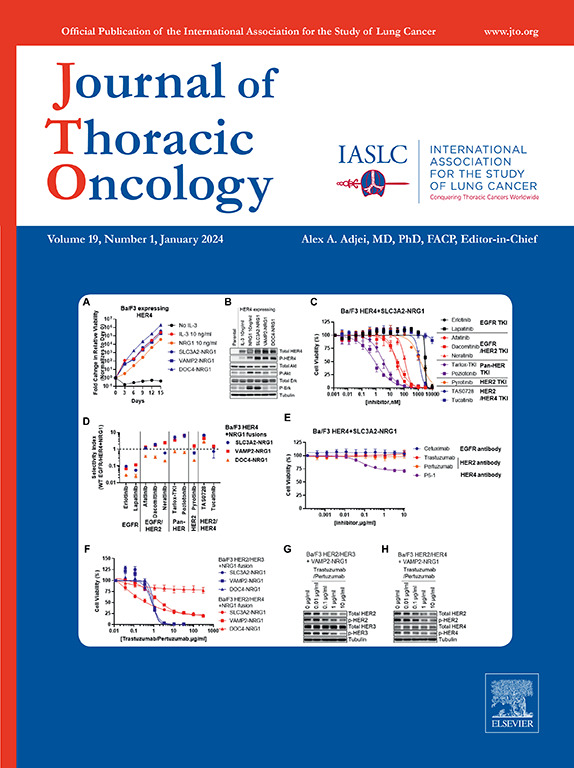Identification of Defined Molecular Subgroups on the Basis of Immunohistochemical Analyses and Potential Therapeutic Vulnerabilities of Pulmonary Carcinoids
IF 21
1区 医学
Q1 ONCOLOGY
引用次数: 0
Abstract
Introduction
Multi-omic studies have identified three molecular separated pulmonary carcinoid (PC) subgroups (A1, A2, B) with distinctive mRNA expression profiles (e.g., orthopedia homeobox protein [OTP], achaete-scute homolog [ASCL1], and hepatocyte nuclear factor 1 homeobox A [HNF1A]). We aimed to establish an immunohistochemical (IHC) biomarker panel that enables subgroup identification, and assessment of its potential clinical relevance.
Methods
All patients with resected pulmonary carcinoids (2003–2012) were identified from the Dutch Cancer/Pathology Registry, and tumors were revised. The IHC expression of OTP, ASCL1, and HNF1A was scored in a blinded fashion in a mRNA-profiled (n = 5 per subgroup) and national carcinoid cohort (N = 478). The expression of potential therapeutic targets (somatostatin receptor type 2a [SSTR2A] and delta-like canonical Notch ligand 3 [DLL3]) was assessed. Immunohistochemistry was assessed using H-scoring.
Results
OTP, ASCL1, and HNF1A reported similar IHC and mRNA expression patterns in the matched primary samples. In the national cohort, IHC separated PCs into subgroups A1 (n = 224 [53%], OTPhigh-ASCL1high-HNF1Alow), A2 (n = 161 [38%], OTPhigh-ASCL1low-HNF1Ahigh), and B (n = 37 [9%], OTPlow-ASCL1low-HNF1Ahigh). In 12% of PCs, no distinct classification could be provided. Patients with A1 were enriched for older age (83% > 50 y), female individuals (83%), and peripheral location (55%) with low SSTR2A (median = 10) and high DLL3 (median = 52) expression. A2 included younger patients (34% < 40 y) and endobronchial/central (87%) tumors with high SSTR2A (median = 160), but low DLL3 (median 0) expression. Group B included more male individuals (59%) and recurrence was more frequent (19%) than in groups A1 (8%) and A2 (6%). Neuroendocrine cell hyperplasia was enriched in A1 (25%) compared with A2 (3%) and B (0%).
Conclusions
An OTP, ASCL1, and HNF1A IHC panel enables the identification of molecular-defined pulmonary carcinoid subgroups with distinct clinical phenotypes and diverging therapeutic vulnerabilities that require further prospective evaluation.

根据免疫组化分析确定肺类癌的分子亚群以及潜在的治疗弱点。
导言:多组学研究发现了三个分子分离的肺类癌(PC)亚组(A1、A2、B),它们具有不同的mRNA表达谱(如OTP/ASCL1/HNF1A)。我们的目标是建立一个免疫组化(IHC)生物标记物面板,以便识别亚组并评估其潜在的临床意义:方法:我们从荷兰癌症/病理登记处确定了所有切除的肺类癌患者(2003-2012 年),并对肿瘤进行了修订。在mRNA分析(n=5/子组)和全国类癌队列(n=478)中,以盲法对OTP/ASCL1/HNF1A的IHC表达进行评分。对潜在治疗靶点(SSTR2A/DLL3)的表达进行了评估。采用H-评分法评估IHC:结果:在匹配的原发性样本中,OTP/ASCL1/HNF1A显示出相似的IHC和mRNA表达模式。在全国队列中,IHC将PC分为A1[n=224(53%),OTP高/ASCL1高/HNF1A低]、A2[n=161(38%),OTP高/ASCL1低/HNF1A高]和B[n=37(9%),OTP低/ASCL1低/HNF1A高]亚组。12%的 PC 无法提供明确的分类。A1 患者年龄较大(83%>50 岁),女性(83%),外周部位(55%),SSTR2A 低表达(中位数 10),DLL3 高表达(中位数 52)。A2 包括较年轻的患者(34%):通过 OTP/ASCL1/HNF1A IHC 面板可以确定分子定义的肺类癌亚组,这些亚组具有不同的临床表型和不同的治疗弱点,需要进一步的前瞻性评估。
本文章由计算机程序翻译,如有差异,请以英文原文为准。
求助全文
约1分钟内获得全文
求助全文
来源期刊

Journal of Thoracic Oncology
医学-呼吸系统
CiteScore
36.00
自引率
3.90%
发文量
1406
审稿时长
13 days
期刊介绍:
Journal of Thoracic Oncology (JTO), the official journal of the International Association for the Study of Lung Cancer,is the primary educational and informational publication for topics relevant to the prevention, detection, diagnosis, and treatment of all thoracic malignancies.The readship includes epidemiologists, medical oncologists, radiation oncologists, thoracic surgeons, pulmonologists, radiologists, pathologists, nuclear medicine physicians, and research scientists with a special interest in thoracic oncology.
 求助内容:
求助内容: 应助结果提醒方式:
应助结果提醒方式:


